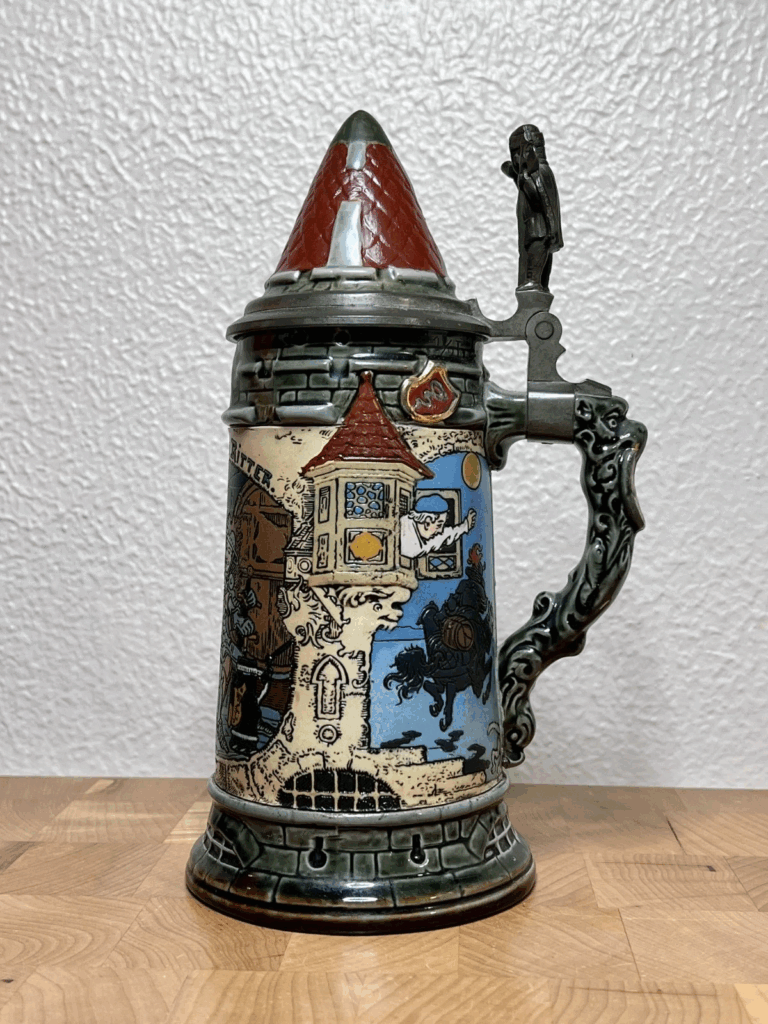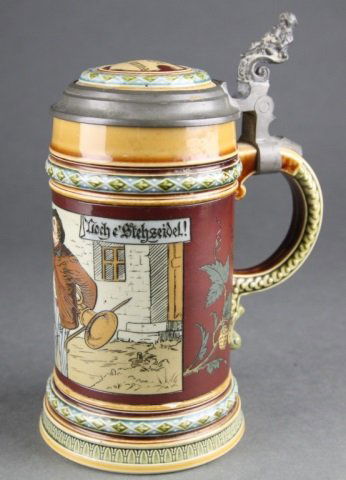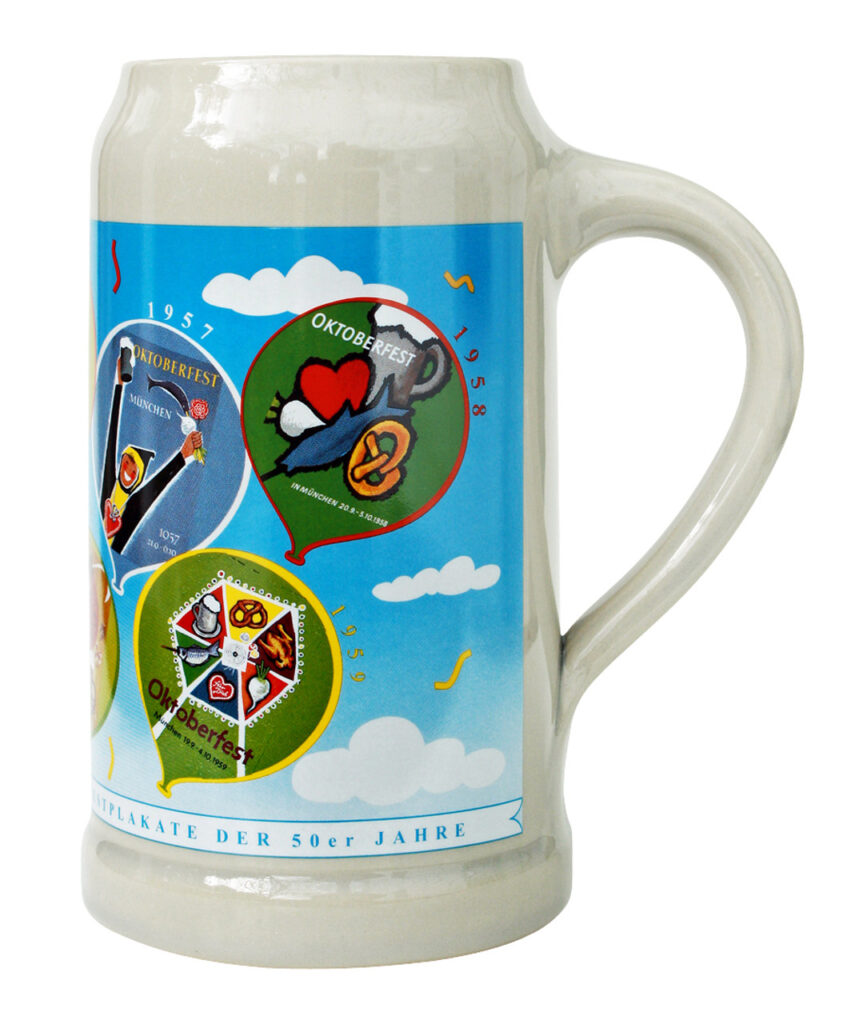10 Rare Beer Steins and Brewery Mugs Collectors Love
Collectors often seek out rare beer steins and brewery mugs for their craftsmanship and the history they represent. The rarity of these items usually comes down to their limited production, distinctive features, or the breweries they came from. Some mugs and steins were created for special events or as promotional pieces, which only adds to their appeal. As these pieces age, their value tends to rise, especially if they are in good condition. If you’re a collector, it’s important to know what makes these items truly rare and valuable.
This post may contain affiliate links, which helps keep this content free. Please read our disclosure for more info.
The Mettlach No. 2382 Thirsty Knight

Produced around 1908 by the German Mettlach factory, this stein features a half-liter size stoneware body, detailed relief work by artist Heinrich Schlitt, and a pewter lid. Its scene of a knight raising his drink and the fine relief finish make it immediately identifiable. Collectors prize it because Mettlach steins from this era represent the company’s craftsmanship before mass production, and because Schlitt-designed pieces have strong name recognition. Market values for a piece in good condition often land in the $3,000-$5,000 range, sometimes higher for perfect examples and rare colorways. Key things to check include original Mettlach marking at the base, integrity of the relief work, and condition of the pewter lid.
The rarity arises from limited production runs and the aging of the stoneware and pewter over a century. Collectors love how the piece bridges art and brewery ware, showing scene, maker, and lid in one. Because the lid and body rarely survive perfectly together, intact examples command premium pricing. For display or investment, provenance adds to the piece’s story and value.
A late-19th-century Mettlach Porcelain Stein with Figural Lid

Made in the 1890s, this porcelain stein by Mettlach features a hand-painted scene of a tavern or drinking hall, has a figural pewter lid, and is smaller in size (e.g., 0.3 L). It is rare because porcelain examples were produced in smaller quantity than standard stoneware, and figural lids add another rarity layer. Collectors are drawn to its rarity of material, fine painting, and maker heritage. Typical market value ranges from $2,500-$4,000 depending on lid style and condition. Important details include the original Mettlach ink mark, correct mold number and minimal restoration.
The figural lid often features elaborate sculpting, and many have been replaced or lost, making intact originals more desirable. The combination of porcelain body, hand-painting, maker mark, and original lid appeals strongly to serious collectors. Condition plays a huge role-hairline cracks or replaced lids reduce value significantly. If you find one in excellent condition with full provenance and original box (if any), the value may climb into the higher end of the estimate.
A Budweiser Holiday Series Stein, early 1980s

This holiday-edition stein was produced by Budweiser in the early 1980s, part of their seasonal series featuring the Clydesdale team and brewery scenes. Its rarity comes from the limited edition release each holiday season and the fact that many were used rather than preserved. Collectors favour it because it links a major brewery brand with a time-limited release and nostalgic appeal. The typical value for a mint version today might sit around $300-$700, although rare colourways or sealed originals may fetch more. Condition checks include whether original box and certificate accompany it, whether the glaze shows wear, and whether the lid is intact and correct.
In the next paragraph, highlight that these are part of brewery memorabilia or breweriana, which adds another layer of interest beyond just the vessel. The seasonal theme means some years had fewer units produced or variants that became rare. Collecting such steins often involves tracking down unopened or little used examples, which attract higher prices. For the collector interested in brand history and pop culture items, this series works well. If you encounter one signed, numbered, or part of a special printing run, the value could edge toward the upper end.
An antique German Jugendstil stylised stein from early 1900s

This stein dates from the Jugendstil (Art Nouveau) era around 1900-1920, made in Germany, typically stoneware or porcelain with flowing organic motifs, floral reliefs, and sometimes silver‐mount lids. Its rarity stems from the combination of age, design style, and often low survival rate of the more artistic pieces. Collectors appreciate the Art Nouveau styling, decorative appeal, and the fact that these are less common than standard brewery or souvenir mugs. Values vary widely, but pieces in good shape can fetch $1,000-$3,000 or more depending on maker and condition. When inspecting one, check for original handle and lid, minimal glaze crazing, correct maker marks, and stable relief.
Point out that the design style makes them decorative as well as functional, so they appeal to both museum-type collectors and breweriana fans. The lids often are silver or pewter and may feature repoussé work, which adds to value when intact. These pieces were less about mass market beer drinking and more about presentation, which means fewer were produced. For someone building a collection of artistic drinkware, this type stands out. If you find provenance or exhibition history, it often nudges the value upward
A West German stoneware stein with pewter lid, post-1949 production marked Made in West Germany

Produced in the 1950s or 1960s, this style of stein reflects the post-war era of craft production in West Germany and is marked accordingly. It becomes rare because fewer older steins from this period survive in excellent condition, especially with original lid and crisp markings. Collectors like these for their transitional place between older historic steins and modern commercially produced mugs. A typical value might range from $200-$500 when condition is solid and markings clear. Condition aspects to verify include whether the lid hinge works, whether the stoneware body has chips or large restoration, and whether the Made in West Germany mark is present.
The pewter lid may have patina, which some collectors value as character. While not as rare as 19th-century pieces, they fill a specific niche of mid-20th-century beer culture. For beginner collectors looking for quality German steins without extremely high cost, these are appealing. When you find one with an original brewery or fest print, that can add another dimension of interest.
A ceramic brewery mug marked for a regional Bavarian brewery

From the 1930s, this mug was produced for a regional Bavarian brewery in stoneware or earthenware and features the brewery’s name plus a scene or crest. It is rare because many small brewers ceased operation or their mugs were discarded, so surviving examples are few. Collectors are drawn to the regional specificity, historical connection to local beer culture, and the maker’s mark. Market value might run around $250-$600, depending on maker, condition, and whether the brewery still exists or its branding is unique. Inspect for intact glaze, legible brewery print, and minimal wear on handle and rim.
A well preserved mug from a now-closed brewery carries both aesthetic and historical appeal. For display purposes, the brewery label or crest gives a story to the piece. If the mug has original capacity markings, rare glaze variations or limited run branding, these factors raise interest. A collector might also check whether the bottom is stamped with maker or capacity, as those add to authenticity and value.
A regimental German stein from pre‐World War I era

This stein was produced around 1910, often in stoneware with military or regimental scenes and includes a pewter lid bearing a unit crest. Its rarity comes from its age, the specificity of the motif, and the fact that wartime destruction and wear reduced surviving numbers. Collectors value the historical connection to military units and the specificity of the relief detail. Market valuation can range from $800-$1,500 or more for scarce regimental versions in good condition. When reviewing one, check that the unit crest is intact, the lid is original and that there are no major repairs.
The relief work is often fine and shows soldiers in action, making them lively pieces. Because the pewter lids often have crests that could be damaged or replaced, original lids matter a lot. Older regimental mugs that still have the original hinge, stamp and body intact are rare finds. For a collection focusing on historic beer vessels with narrative, this sort of stein is a strong candidate.
A limited-edition figural stein by a twentieth-century maker (e.g., featuring a beer character)

Produced in the mid-20th century, this stein features a figurine character molded into the body and includes a branded brewery lid. It becomes rare because figural molds typically had smaller production runs and fewer survived intact. Collectors like them for their visual novelty, storytelling quality, and their connection to advertising or branding history. Values commonly are in the $300-$900 range, rising if the figure is rare, the paint is in near-mint condition, and the maker is well known. Key details to check: original paint finish, correct lid branded to brewery, and matching maker mark.
The character design appeals both to stein collectors and those interested in brewery-brand memorabilia. Some may have serialized numbers or were limited runs, which increases interest. If the stein retains its original box or certificate, it may command higher value. For someone who enjoys the intersection of art, beer culture and collectible messaging, this type fits well.
A commemorative Oktoberfest stein issued by a Munich brewer, mid-20th century

Issued by a Munich brewery around the 1950s-1970s for the annual festival, this lidded stein bears the brewer’s logo, the Oktoberfest year, and a festive design. It is rare because each year’s design changes and many remain in use or break, so intact examples from older years become scarce. Collectors value it for its tie to one of the world’s major beer events, the brewer’s branding, and the fact that festival steins have a date and story. Market values may lie around $400-$800, with variants or specially numbered editions going higher. Check for clear date, original pint or half-liter capacity marking, lid intact and hinge operational, and minimal wear on the exterior.
The brewer’s logo and festival date give context and collectibility. Some years saw fewer units produced or special gold-accent runs, which elevates interest. For someone collecting festival breweriana, this type serves as both drinkware and memorabilia. Finding one with original certificate or in original box may increase its appeal.
A large 1.5 L German lidded stein from West Germany era

This oversized piece was produced in West Germany after WWII, around the 1950s or 1960s, marked Made in West Germany on the base, stoneware body, pewter lid, 1.5 L capacity. Its rarity stems from its large capacity and fewer survivors in good shape because of the size and weight. Collectors are drawn to it because of size, capacity, country marking, and the fact that such large steins double as display pieces. Market value for one in good shape might be around $300-$600, again depending on markings and condition. Key signs to check: correct West Germany stamp, capacity imprint, intact lid hinge, no major damage or restoration.
Their size makes them statement pieces which many collectors display rather than drink from, which shifts preference to condition over utility. Because the Made in West Germany era is fixed, these steins tell a post-war story of German manufacturing and beer culture. For someone focusing on size variation or country of origin marks in their collection, this one fits. Finding one marked with a specific brewer or festival increases interest further.
This article originally appeared on Avocadu.
